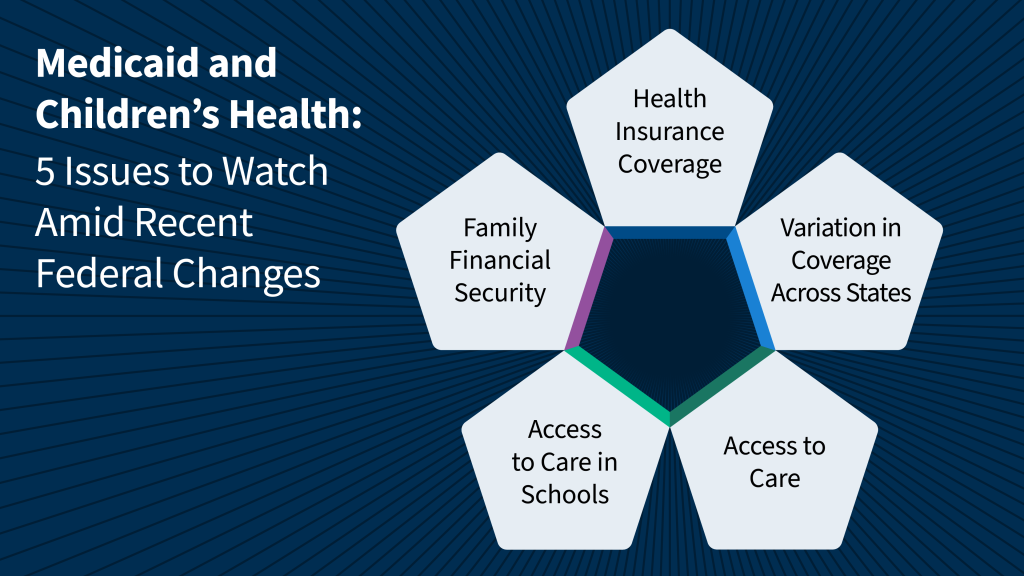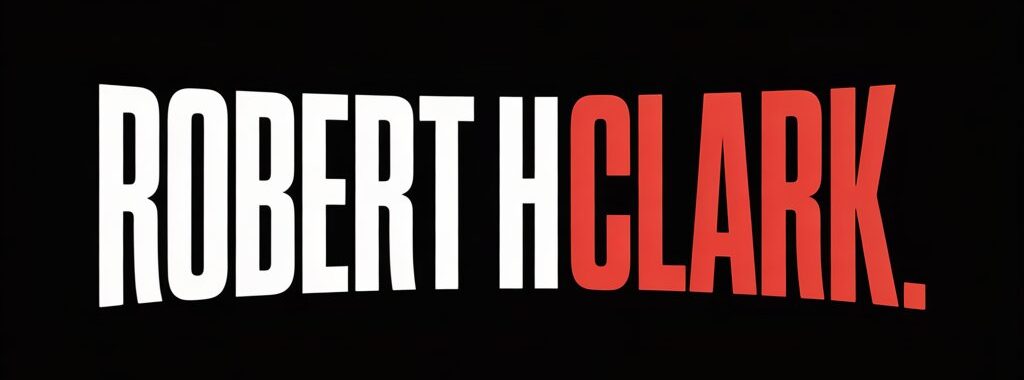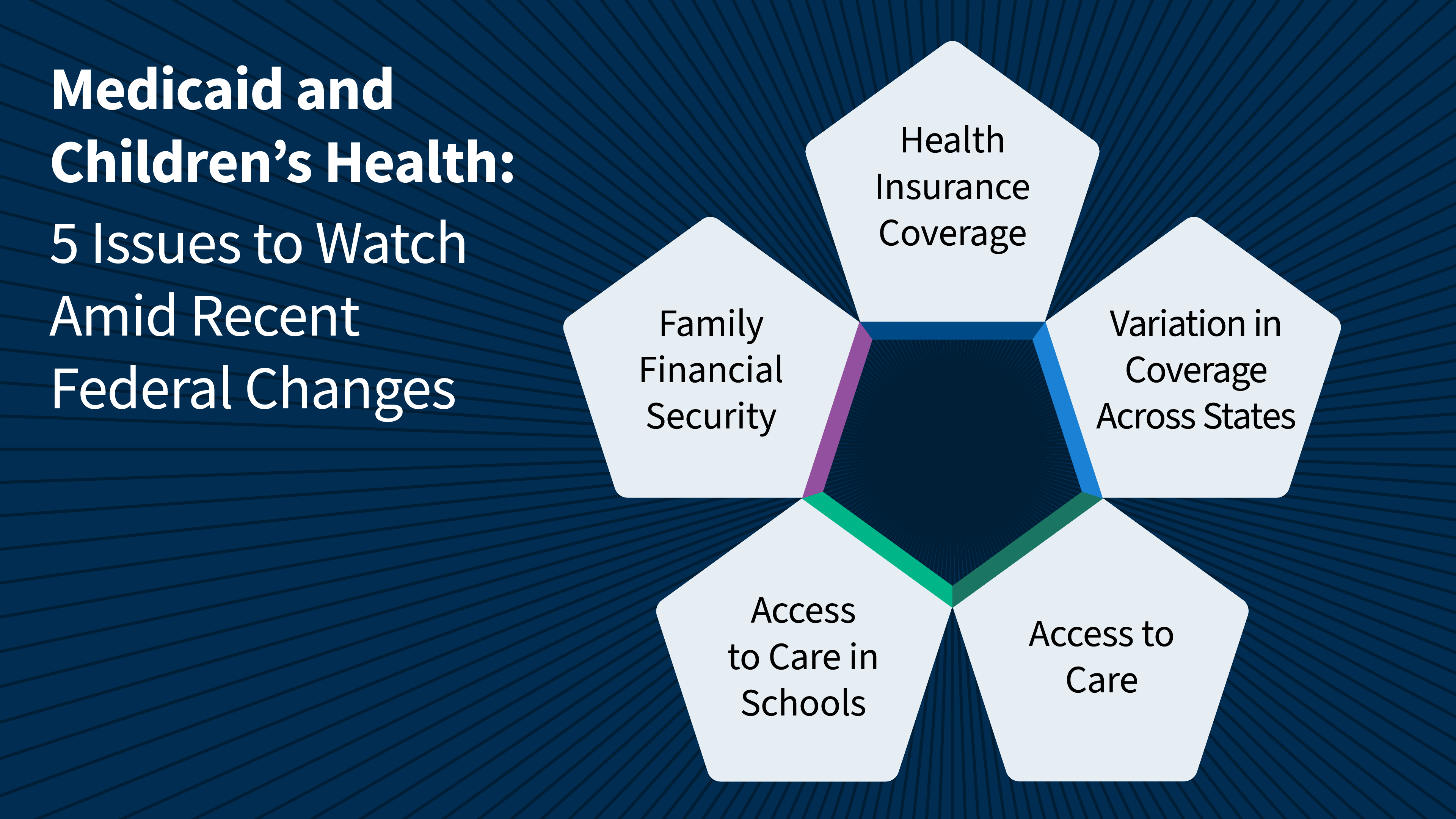The uninsured charge, supplemental poverty charge, and meals insecurity for youngsters have all elevated for the reason that expiration of pandemic-era fiscal aid, and excessive family prices, together with health care costs, are placing stress on household budgets. After growing through the pandemic, total federal spending on kids as a share of the financial system (or GDP) has declined and is projected to proceed to say no additional over the following 10 years. On the similar time, over the past decade, rates of chronic conditions amongst kids, together with obesity and mental health concerns, have elevated. On the similar time, kids’s routine vaccination charges are declining, and many states are contending with measles outbreaks. Current federal modifications (Field 1), together with the just lately handed reconciliation law, administrative actions by the Facilities for Medicare & Medicaid Providers (CMS), and different broader Trump administration modifications, might have additional implications for youngsters and their well being and well-being. Almost 4 in 10 kids within the U.S. are lined by Medicaid, making this system (and modifications to this system) notably related to broader kids’s well being traits. This concern transient explores the most recent knowledge on Medicaid and youngsters’s well being and highlights 5 key points to observe as federal modifications are carried out (Determine 1).
Determine 1

Field 1: Main Federal Adjustments that May Impression Kids’s Well being
2025 Federal Finances Reconciliation Regulation (H.R. 1): The reconciliation legislation, handed on July 4, 2025, consists of vital well being care coverage modifications. Whereas most of the provisions within the new legislation don’t straight goal kids, modifications might have implications for youngsters’s protection and entry to well being providers:
- Protection losses: The Congressional Finances Workplace (CBO) projected that H.R. 1 will enhance the number of uninsured individuals by 10 million over the following decade (or by greater than 14 million if mixed with the expiration of the Inexpensive Care Act’s (ACA) enhanced premium tax credit). It’s unclear how most of the newly uninsured are projected to be kids. Nevertheless, lack of Medicaid protection amongst mother and father (from elevated renewals or work necessities) might impression kids’s protection as analysis has shown that growing protection for folks will increase kids’s protection.
- Federal spending cuts: H.R. 1 is predicted to cut back federal Medicaid spending by $911 billion over the following decade, although the impression of the reductions will vary across states. In response to some financing modifications, states might scale back supplier charges which might have implications for entry to look after enrollees together with kids. The brand new legislation additionally reduces federal Supplemental Vitamin Help Program (SNAP) spending by $187 billion, which might end in an estimated 1 million kids with decreased or eradicated meals help. Whereas the reconciliation legislation did make modest increases to some baby care tax advantages, together with the Little one Tax Credit score, the CBO expects the reconciliation provisions, taken collectively, will redistribute wealth from the bottom earnings households to the best incomes, largely attributable to Medicaid and SNAP cuts.
CMS Administrative Actions: Amongst other waiver modifications, CMS has restricted Medicaid waivers for multi-year steady eligibility for Medicaid and Kids’s Well being Insurance coverage Program (CHIP) kids, a coverage at present adopted by 12 states to eradicate gaps in protection for youngsters throughout early childhood. As well as, by each the reconciliation law and executive action, the Trump administration has restricted immigrant eligibility for federal public advantages, which might scale back entry to well being look after immigrant kids and their households.
Broader Trump Administration Adjustments: The Make America Wholesome Once more (MAHA) fee, led by HHS Secretary Robert F. Kennedy (RFK) Jr., has sought to make clear current traits and establish suggestions to enhance kids’s well being. The most recent MAHA strategy report consists of proposals to handle kids’s “poor food plan”, “chemical publicity”, “lack of bodily exercise and power stress”, and “overmedicalization”, although implementation details stay unclear. Secretary Kennedy has additionally led current efforts to re-examine the federal childhood vaccine schedule, exchange the committee that creates childhood vaccine suggestions, and limit access to COVID-19 vaccines and mRNA vaccine analysis.
The Trump Administration has additionally laid off workers throughout governmental businesses, together with on the Division of Human Providers (HHS) and the Division of Training (DOE), and reduced support for state and native well being departments. At DOE specifically, over half of the workers has been reduce, including the workplace chargeable for particular training. Grant funding for faculties has additionally been delayed, together with funds to help and expand school-based psychological well being providers.
Lastly, tariffs carried out by the Trump Administration are expected to drive up prices for households (together with health care costs).
1. Well being Insurance coverage Protection
The uninsured charge for youngsters has declined over time however has elevated up to now two years. The uninsured charge for youngsters has declined from 10.4% in 2008 to 6.0% in 2024 (Determine 2), largely attributable to insurance policies on the state and federal stage that expanded and streamlined Medicaid protection, together with the ACA Medicaid enlargement. The kids’s uninsured charge fell to an all-time low in 2016 (4.7%) earlier than ticking up through the first Trump administration, when usually favorable financial circumstances in addition to Trump administration coverage modifications led to declines in Medicaid enrollment. The kids’s uninsured charge declined once more following the onset of the COVID-19 pandemic, however did increase barely from 5.1% in 2022 to five.3% in 2023 (a statistically vital enhance of 0.2%), pushed by a decline in Medicaid protection as kids misplaced protection as a result of unwinding of the Medicaid steady enrollment provision, a pandemic-era coverage. These traits continued in 2024, and up to date federal modifications might additional scale back kids’s Medicaid protection and increase the variety of kids who’re uninsured within the coming years.
2. Variation in Protection Throughout States
The share of youngsters lined by Medicaid varies considerably by state. General, Medicaid covers almost 4 in 10 kids within the U.S., however the share of youngsters lined by Medicaid in every state varies, starting from beneath 20% in Utah to over 60% in New Mexico (Determine 3). Seven states (Alabama, Kentucky, Oklahoma, Arkansas, Mississippi, Louisiana, and New Mexico) have over 45% of youngsters enrolled in Medicaid. Medicaid additionally funds about 4 in 10 births nationally and over half of births in 4 states (Louisiana, Mississippi, New Mexico, Oklahoma). This system performs a very giant position in rural areas, paying for almost half of all births in rural communities and serving to to shore up financing for hospitals in rural areas affected by supplier shortages. Analysis additionally exhibits that Medicaid enrollment in childhood can lead to higher well being outcomes all through life, increase earnings in maturity, and doubtlessly scale back future federal spending. A variety of states have expanded entry to Medicaid and CHIP protection for youngsters for the reason that pandemic started, however current federal efforts might reverse this pattern. The magnitude of Medicaid price range cuts stemming from the reconciliation legislation and the extent to which kids could also be impacted will vary across states, relying on state traits in addition to how states implement and reply to numerous provisions.
3. Entry to Care
Uninsured kids usually tend to forgo wanted care than kids with medical insurance protection. Analysis has proven that well being protection supplies kids with access to needed care, and survey knowledge present uninsured kids are extra probably than these with personal insurance coverage or Medicaid to report going with out wanted care attributable to price and that that they had not seen a health care provider up to now 12 months (Determine 4). Medicaid’s profit package deal for youngsters, Early and Periodic Screening, Diagnostic and Treatment (EPSDT), helps meet kids’s well being care wants and protects them from excessive out-of-pocket prices. Underneath EPSDT, states are required to cowl major care and screening providers for youngsters properly as any providers “crucial… to appropriate or ameliorate” a toddler’s bodily or psychological well being situation. That is particularly essential for children with special health care needs as Medicaid provides extra complete protection for youngsters than the standard personal insurance coverage plan and will increase entry to wanted providers that enhance the standard of every day life, together with long-term care and home care.
Some kids with Medicaid nonetheless face obstacles to accessing care. Administrative knowledge have proven that solely half of Medicaid enrolled kids obtain a well-child visit or any form of dental service inside the 12 months. These low charges point out Medicaid kids face obstacles to accessing care, together with a scarcity of obtainable suppliers of their neighborhood. Kids may expertise challenges accessing behavioral well being care, with 57% of youngsters reporting difficulties acquiring psychological well being care in 2023. Supplier charge cuts in response to current federal modifications might scale back entry to care, probably contributing to even decrease charges of utilization amongst kids and exacerbating entry points for providers similar to behavioral well being care. Different broader Trump administration modifications might even have implications for entry, together with recent changes to vaccine suggestions in addition to MAHA fee proposals to boost prior authorization necessities to forestall “the overuse of medicines in school-age kids—notably for circumstances similar to ADHD”.
4. Entry to Care in Colleges
Medicaid protection can facilitate entry to care for youngsters, together with kids with particular training plans, in class. There are an estimated 7 million children, or 10% of all kids within the U.S., who at present have particular training plans. This consists of kids receiving particular training providers beneath a particular training or early intervention plan (usually an Individualized Training Plan (IEP) or Individualized Household Service Plan). Medicaid covers half of all kids with particular training plans, although the share varies by state starting from 26% in New Jersey to 73% in Kentucky (Determine 5). Medicaid supplies vital financing for the supply of providers in faculties including reimbursement for medically necessary providers which can be a part of a pupil’s particular training plan, for eligible well being providers for college kids with Medicaid protection extra broadly, and for some administrative actions. Current federal cuts are anticipated to squeeze faculty district budgets, doubtlessly affecting faculty providers and reducing access, together with for college kids with particular training plans.
As youth psychological well being considerations have grown, each the federal authorities and states have taken motion to expand entry to school-based psychological well being care. Colleges obtain help for offering psychological well being providers in a number of methods, together with help on the federal stage by DOE and HHS, in addition to by Medicaid, and almost one in five college students attending public faculties within the U.S. make the most of school-based psychological well being providers. Faculty-based psychological well being providers can enhance access to care and scale back entry obstacles for underserved populations, together with children from low-income households and children of color. Current cuts, together with reductions in coverages in addition to cuts to DOE and HHS workers, might dampen current efforts to extend entry to psychological well being care in schools.
5. Household Monetary Safety
Kids with Medicaid expertise greater charges of meals insecurity than kids total. Survey knowledge present that 19% of all kids within the U.S. and 30% of youngsters lined by Medicaid dwell in households that have food insecurity, which means they’re unable to entry ample meals attributable to lack of cash or different sources (Determine 6). U.S. Division of Agriculture (USDA) knowledge additionally present that meals insecurity amongst kids has increased lately. Meals insecurity is related to multiple chronic conditions, poorer self-reported health status, higher health care utilization, and lower rates of medication adherence. General, 19% of youngsters, and 41% of youngsters with Medicaid, obtain SNAP advantages. Several studies point out that people who obtain SNAP advantages have higher well being and decrease charges of meals insecurity than related people who find themselves eligible however not receiving these advantages. Whereas the MAHA fee highlights the significance of diet in current suggestions, federal SNAP cuts within the reconciliation legislation might worsen entry to meals for youngsters.
Medicaid covers 8 in 10 kids dwelling in poverty or over 9 million of the virtually 12 million kids who lived in poverty in 2023 (measured utilizing the official poverty measure; the poverty threshold for a household with two adults and one baby was $24,526 in 2023). New knowledge present that from 2023 to 2024 the official poverty charge for youngsters declined slightly and the supplemental poverty charge, which accounts for a wider set of sources, held regular; nonetheless, the supplemental poverty charge for youngsters stays greater than double what it was in 2021 as a result of expiration of pandemic-era federal help. Inflation has cooled since 2022, however family prices remain high, contributing to further monetary hardship and elevated meals insecurity for households. Federal cuts within the reconciliation legislation and different current federal modifications might worsen affordability challenges and will result in additional increases in poverty and, in the end, poorer well being outcomes.






